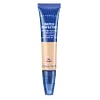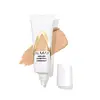What's inside
What's inside
 Key Ingredients
Key Ingredients

 Benefits
Benefits

 Concerns
Concerns

 Ingredients Side-by-side
Ingredients Side-by-side

Cyclopentasiloxane
EmollientC12-15 Alkyl Benzoate
AntimicrobialGlycerin
HumectantDimethicone
EmollientTalc
AbrasivePolymethyl Methacrylate
PEG-10 Dimethicone
Skin ConditioningDimethicone/PEG-10/15 Crosspolymer
Acrylates/Dimethicone Copolymer
Skin ConditioningBoron Nitride
AbsorbentDimethiconol
EmollientMagnesium Sulfate
Nylon-12
Aluminum Dimyristate
Emulsion StabilisingTriethoxycaprylylsilane
Phenoxyethanol
PreservativeTocopheryl Acetate
AntioxidantCaprylyl Glycol
EmollientDisodium Stearoyl Glutamate
CleansingPunica Granatum Fruit Juice
MaskingVitis Vinifera Juice
AntioxidantPotassium Sorbate
PreservativeHexylene Glycol
EmulsifyingAscorbyl Glucoside
AntioxidantEuterpe Oleracea Juice
Skin ConditioningDipropylene Glycol
HumectantTocopherol
AntioxidantSilica
AbrasiveSapphire Powder
Palmaria Palmata Extract
Skin ProtectingCI 77891
Cosmetic ColorantIron Oxides
CI 77007
Cosmetic ColorantCyclopentasiloxane, C12-15 Alkyl Benzoate, Glycerin, Dimethicone, Talc, Polymethyl Methacrylate, PEG-10 Dimethicone, Dimethicone/PEG-10/15 Crosspolymer, Acrylates/Dimethicone Copolymer, Boron Nitride, Dimethiconol, Magnesium Sulfate, Nylon-12, Aluminum Dimyristate, Triethoxycaprylylsilane, Phenoxyethanol, Tocopheryl Acetate, Caprylyl Glycol, Disodium Stearoyl Glutamate, Punica Granatum Fruit Juice, Vitis Vinifera Juice, Potassium Sorbate, Hexylene Glycol, Ascorbyl Glucoside, Euterpe Oleracea Juice, Dipropylene Glycol, Tocopherol, Silica, Sapphire Powder, Palmaria Palmata Extract, CI 77891, Iron Oxides, CI 77007
Water
Skin ConditioningDimethicone
EmollientGlycerin
HumectantCaprylyl Methicone
Skin ConditioningDimethicone/PEG-10/15 Crosspolymer
Niacinamide
SmoothingDiphenylsiloxy Phenyl Trimethicone
Skin ConditioningPEG-10 Dimethicone
Skin ConditioningPentylene Glycol
Skin ConditioningAmmonium Acryloyldimethyltaurate/Vp Copolymer
Magnesium Sulfate
Sodium Chloride
Masking1,2-Hexanediol
Skin ConditioningAlumina
AbrasiveBis-PEG/PPG-14/14 Dimethicone
EmollientCaprylyl Glycol
EmollientCetyl PEG/PPG-10/1 Dimethicone
EmulsifyingLecithin
EmollientSilica
AbrasiveSodium Hyaluronate
HumectantTetrahexyldecyl Ascorbate
AntioxidantTetrasodium EDTA
Tocopheryl Acetate
AntioxidantTriethoxycaprylylsilane
Trimethylsiloxysilicate
EmollientPhenoxyethanol
PreservativeCI 77163
Cosmetic ColorantCI 77491
Cosmetic ColorantCI 77492
Cosmetic ColorantCI 77499
Cosmetic ColorantCI 77891
Cosmetic ColorantWater, Dimethicone, Glycerin, Caprylyl Methicone, Dimethicone/PEG-10/15 Crosspolymer, Niacinamide, Diphenylsiloxy Phenyl Trimethicone, PEG-10 Dimethicone, Pentylene Glycol, Ammonium Acryloyldimethyltaurate/Vp Copolymer, Magnesium Sulfate, Sodium Chloride, 1,2-Hexanediol, Alumina, Bis-PEG/PPG-14/14 Dimethicone, Caprylyl Glycol, Cetyl PEG/PPG-10/1 Dimethicone, Lecithin, Silica, Sodium Hyaluronate, Tetrahexyldecyl Ascorbate, Tetrasodium EDTA, Tocopheryl Acetate, Triethoxycaprylylsilane, Trimethylsiloxysilicate, Phenoxyethanol, CI 77163, CI 77491, CI 77492, CI 77499, CI 77891
 Reviews
Reviews

Ingredients Explained
These ingredients are found in both products.
Ingredients higher up in an ingredient list are typically present in a larger amount.
Caprylyl Glycol is a humectant and emollient, meaning it attracts and preserves moisture.
It is a common ingredient in many products, especially those designed to hydrate skin. The primary benefits are retaining moisture, skin softening, and promoting a healthy skin barrier.
Though Caprylyl Glycol is an alcohol derived from fatty acids, it is not the kind that can dry out skin.
This ingredient is also used as a preservative to extend the life of products. It has slight antimicrobial properties.
Learn more about Caprylyl GlycolCi 77891 is a white pigment from Titanium dioxide. It is naturally found in minerals such as rutile and ilmenite.
It's main function is to add a white color to cosmetics. It can also be mixed with other colors to create different shades.
Ci 77891 is commonly found in sunscreens due to its ability to block UV rays.
Learn more about CI 77891Dimethicone is a type of synthetic silicone created from natural materials such as quartz.
What it does:
Dimethicone comes in different viscosities:
Depending on the viscosity, dimethicone has different properties.
Ingredients lists don't always show which type is used, so we recommend reaching out to the brand if you have questions about the viscosity.
This ingredient is unlikely to cause irritation because it does not get absorbed into skin. However, people with silicone allergies should be careful about using this ingredient.
Note: Dimethicone may contribute to pilling. This is because it is not oil or water soluble, so pilling may occur when layered with products. When mixed with heavy oils in a formula, the outcome is also quite greasy.
Learn more about DimethiconeDimethicone/PEG-10/15 Crosspolymer is a type of silicone.
Glycerin is already naturally found in your skin. It helps moisturize and protect your skin.
A study from 2016 found glycerin to be more effective as a humectant than AHAs and hyaluronic acid.
As a humectant, it helps the skin stay hydrated by pulling moisture to your skin. The low molecular weight of glycerin allows it to pull moisture into the deeper layers of your skin.
Hydrated skin improves your skin barrier; Your skin barrier helps protect against irritants and bacteria.
Glycerin has also been found to have antimicrobial and antiviral properties. Due to these properties, glycerin is often used in wound and burn treatments.
In cosmetics, glycerin is usually derived from plants such as soybean or palm. However, it can also be sourced from animals, such as tallow or animal fat.
This ingredient is organic, colorless, odorless, and non-toxic.
Glycerin is the name for this ingredient in American English. British English uses Glycerol/Glycerine.
Learn more about GlycerinMagnesium Sulfate is a salt. More specifically, it is an epsom salt, or the bath salt used to help relieve muscle aches.
Despite having ‘sulfate’ in the name, it isn’t a surfactant or cleansing agent like sodium lauryl sulfate. Unlike those sulfates, magnesium sulfate doesn’t have the same cleansing or foaming properties (it's simply a type of salt).
In cosmetics, Magnesium Sulfate is used to thicken a product or help dilute other solids. It is a non-reactive and non-irritating ingredient.
One study shows magnesium deficiency may lead to inflammation of the skin. Applying magnesium topically may help reduce inflammation.
You can find this ingredient in sea water or mineral deposits.
Learn more about Magnesium SulfatePeg-10 Dimethicone is silicone with conditioner and emulsifier properties. It mostly acts as an emollient in skincare and and humectant in haircare.
According to the manufacturer, acidic formulations decrease the stability of this ingredient. It works best in neutral or near neutral formulations.
Phenoxyethanol is a preservative that has germicide, antimicrobial, and aromatic properties. Studies show that phenoxyethanol can prevent microbial growth. By itself, it has a scent that is similar to that of a rose.
It's often used in formulations along with Caprylyl Glycol to preserve the shelf life of products.
Silica, also known as silicon dioxide, is a naturally occurring mineral. It is used as a fine, spherical, and porous powder in cosmetics.
Though it has exfoliant properties, the function of silica varies depending on the product.
The unique structure of silica enhances the spreadability and adds smoothness, making it a great texture enhancer.
It is also used as an active carrier, emulsifier, and mattifier due to its ability to absorb excess oil.
In some products, tiny microneedles called spicules are made from silica or hydrolyzed sponge. When you rub them in, they lightly polish away dead skin layers and enhance the penetration of active ingredients.
Learn more about SilicaTocopheryl Acetate is AKA Vitamin E. It is an antioxidant and protects your skin from free radicals. Free radicals damage the skin by breaking down collagen.
One study found using Tocopheryl Acetate with Vitamin C decreased the number of sunburned cells.
Tocopheryl Acetate is commonly found in both skincare and dietary supplements.
Learn more about Tocopheryl AcetateTriethoxycaprylylsilane is a silicone used to bind and stabilize ingredients.
As an emulsifier, it helps prevent ingredients from separating. This can help elongate the shelf life of products.
Triethoxycaprylylsilane is often used to coat mineral sunscreens ingredients to help give a better feel. It also helps reduce oxidative stress in sunscreens.
Learn more about Triethoxycaprylylsilane